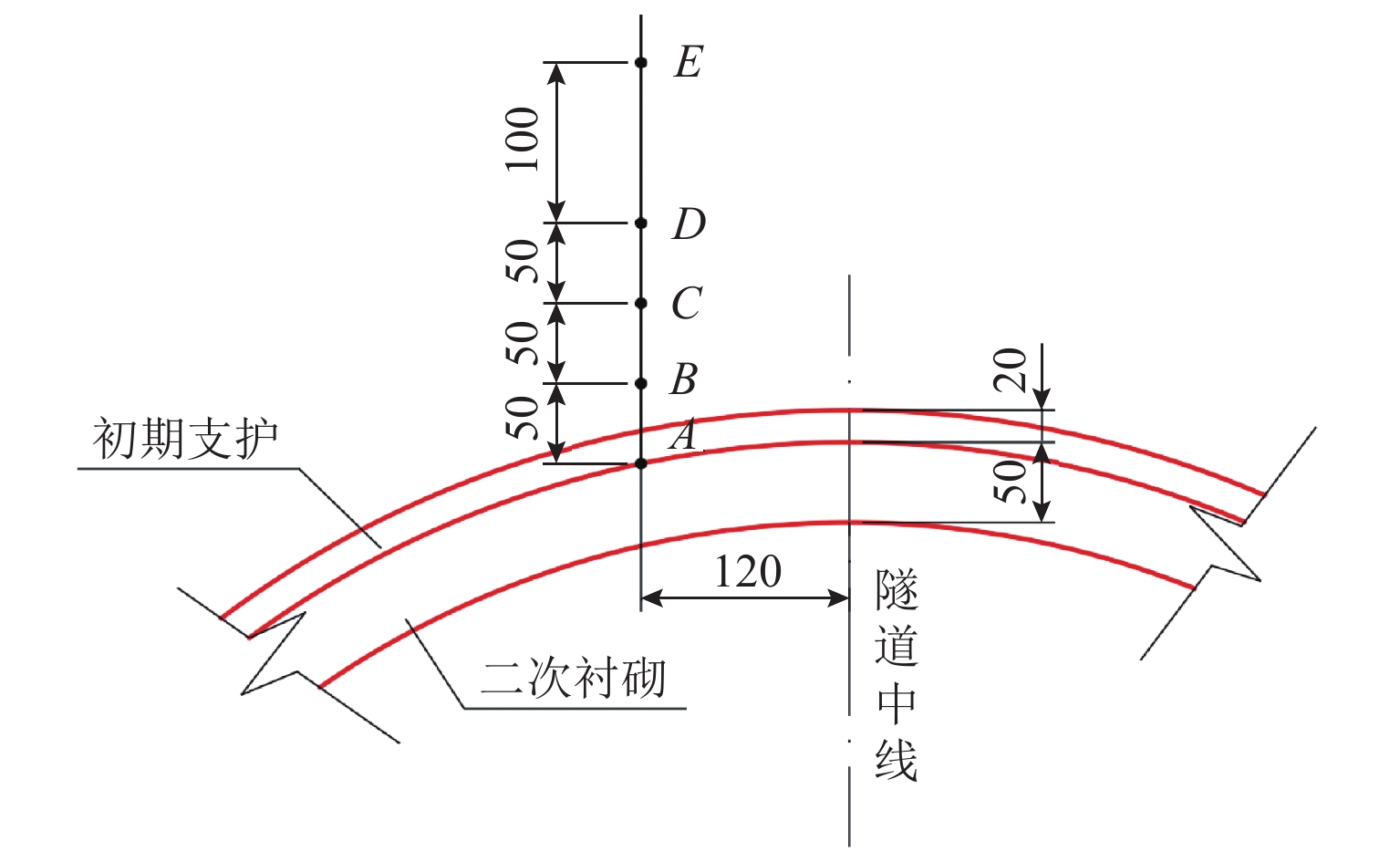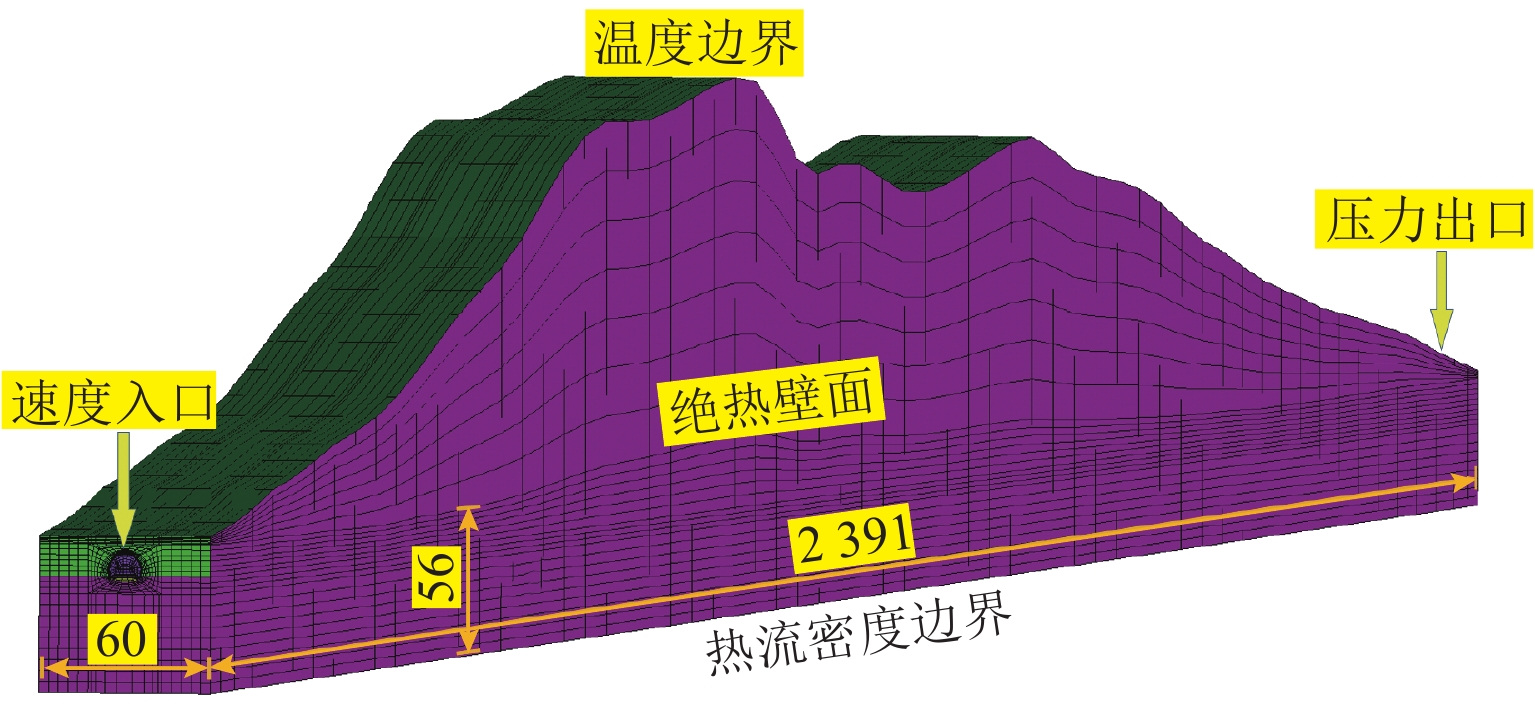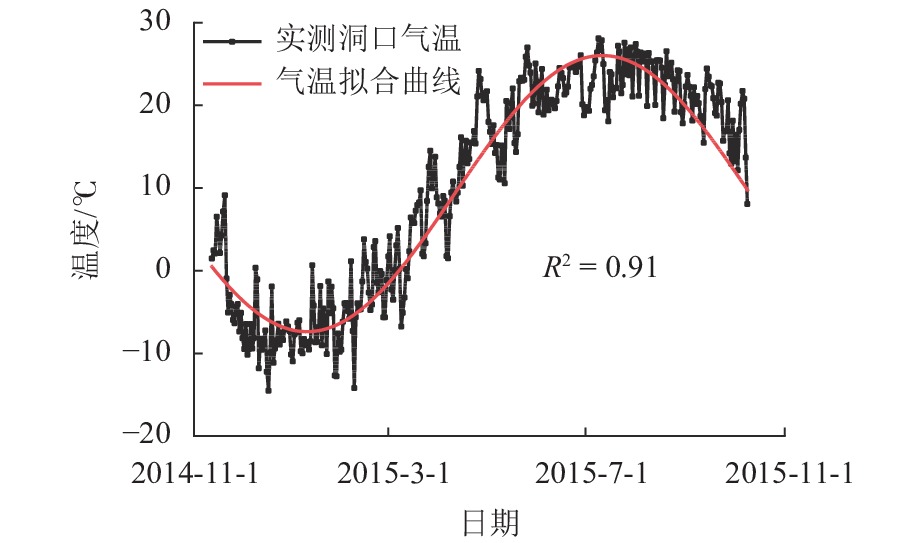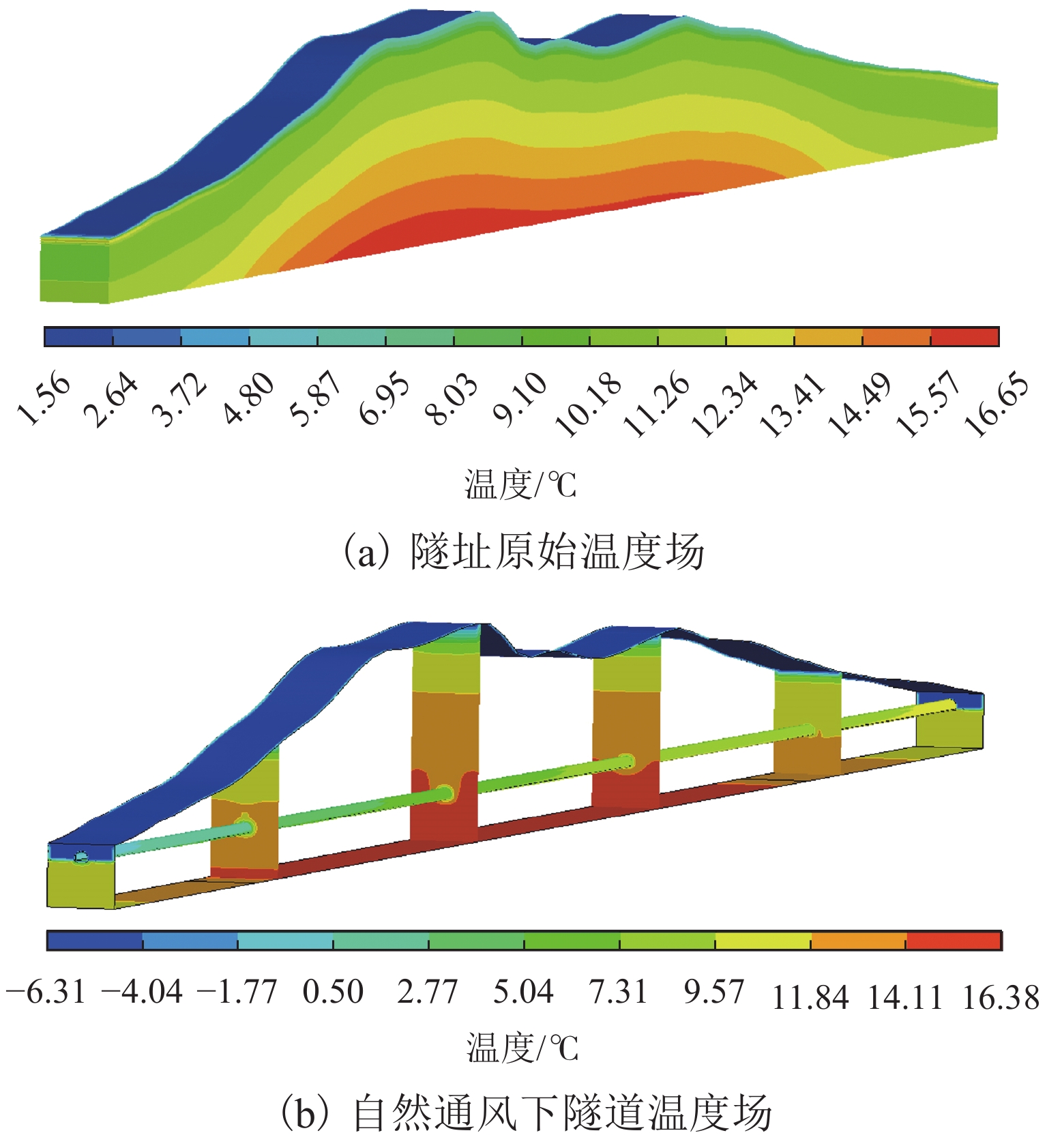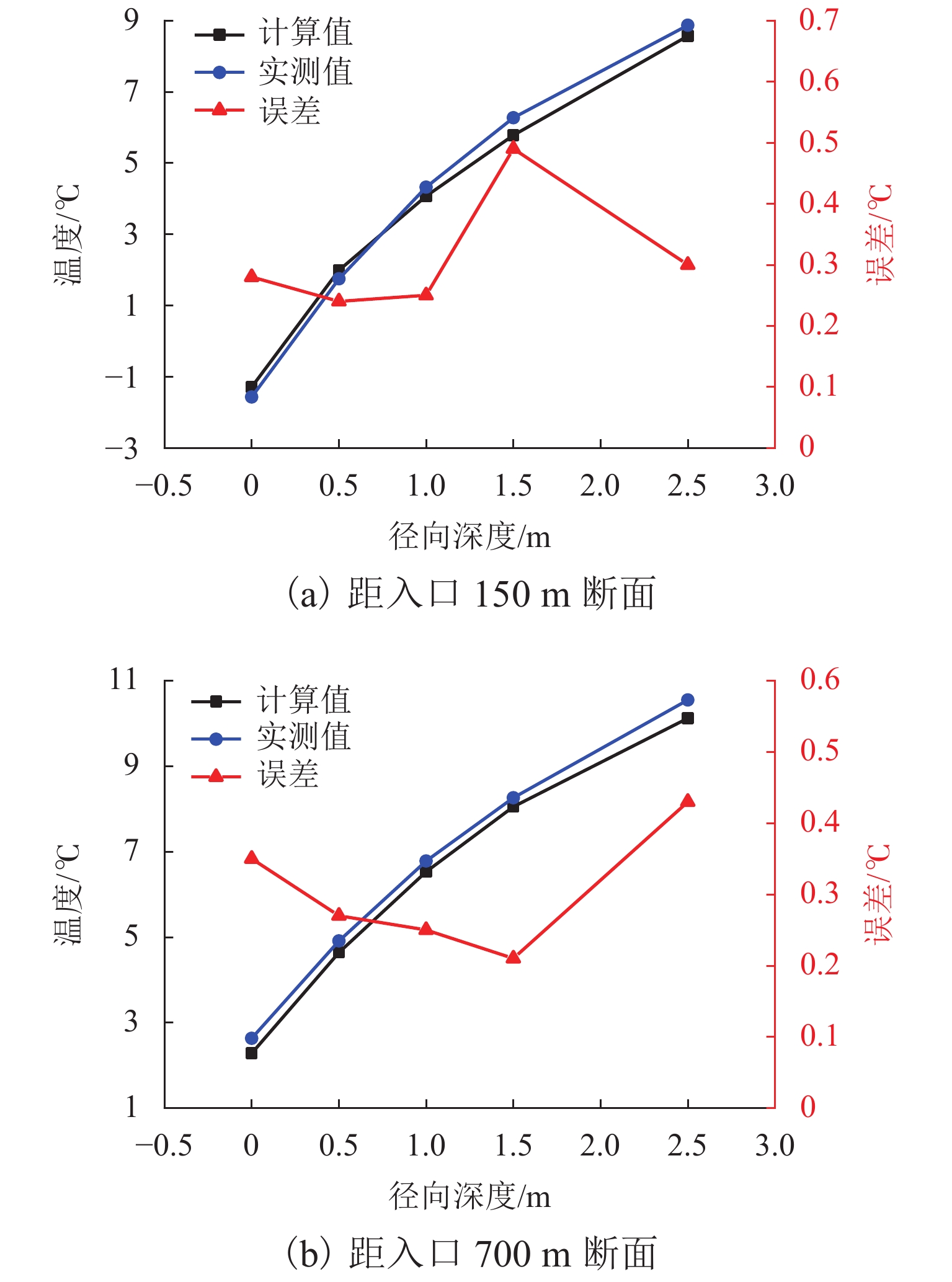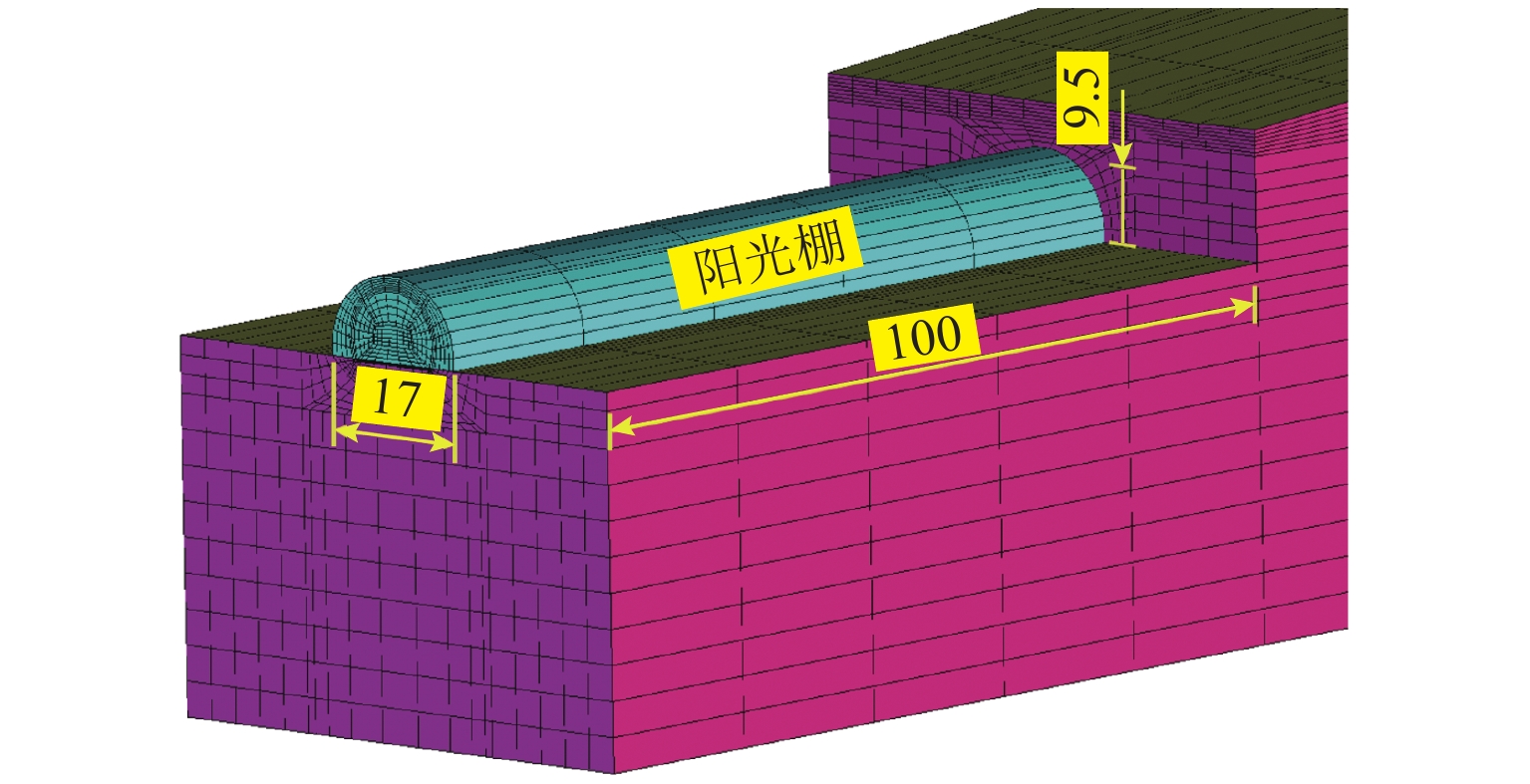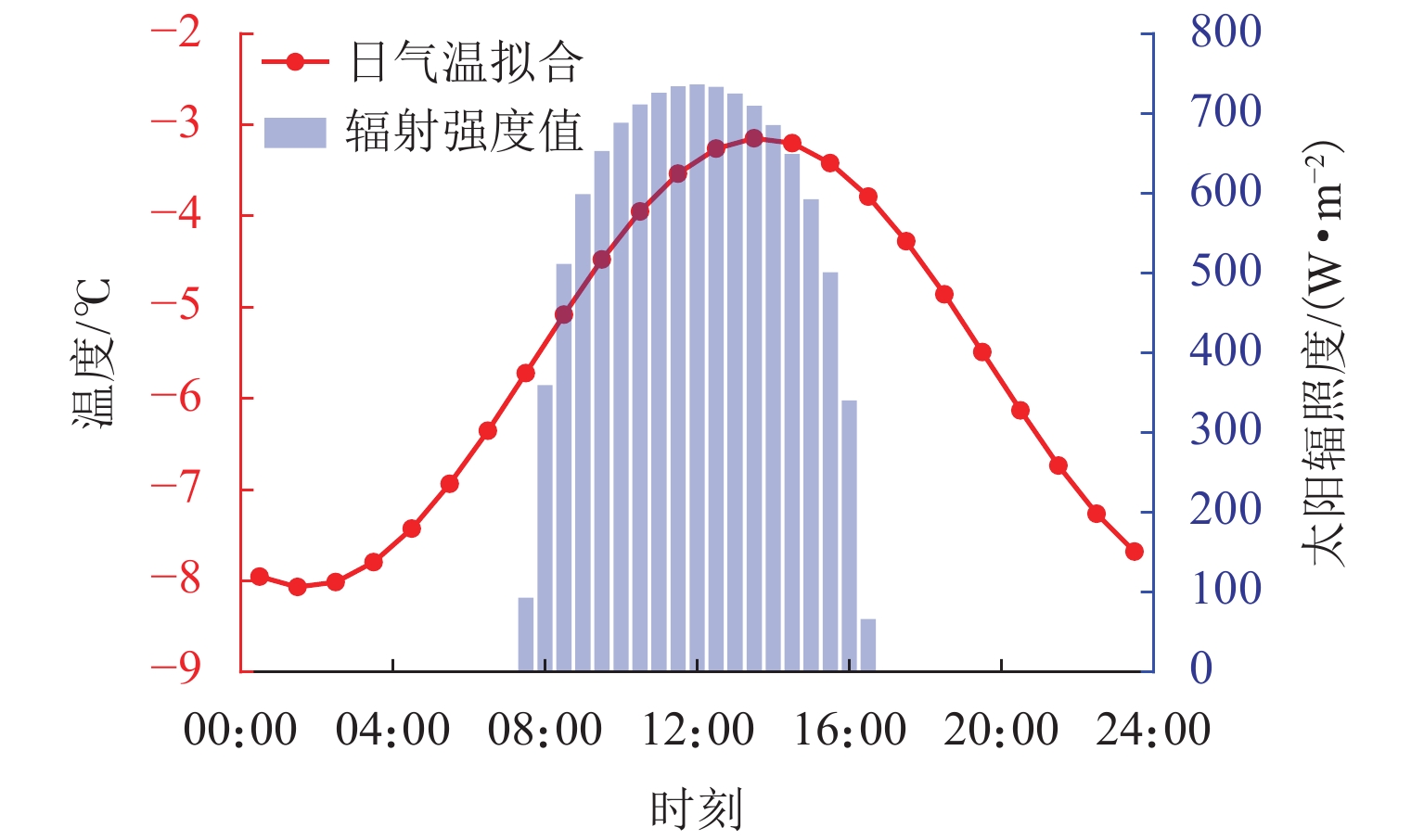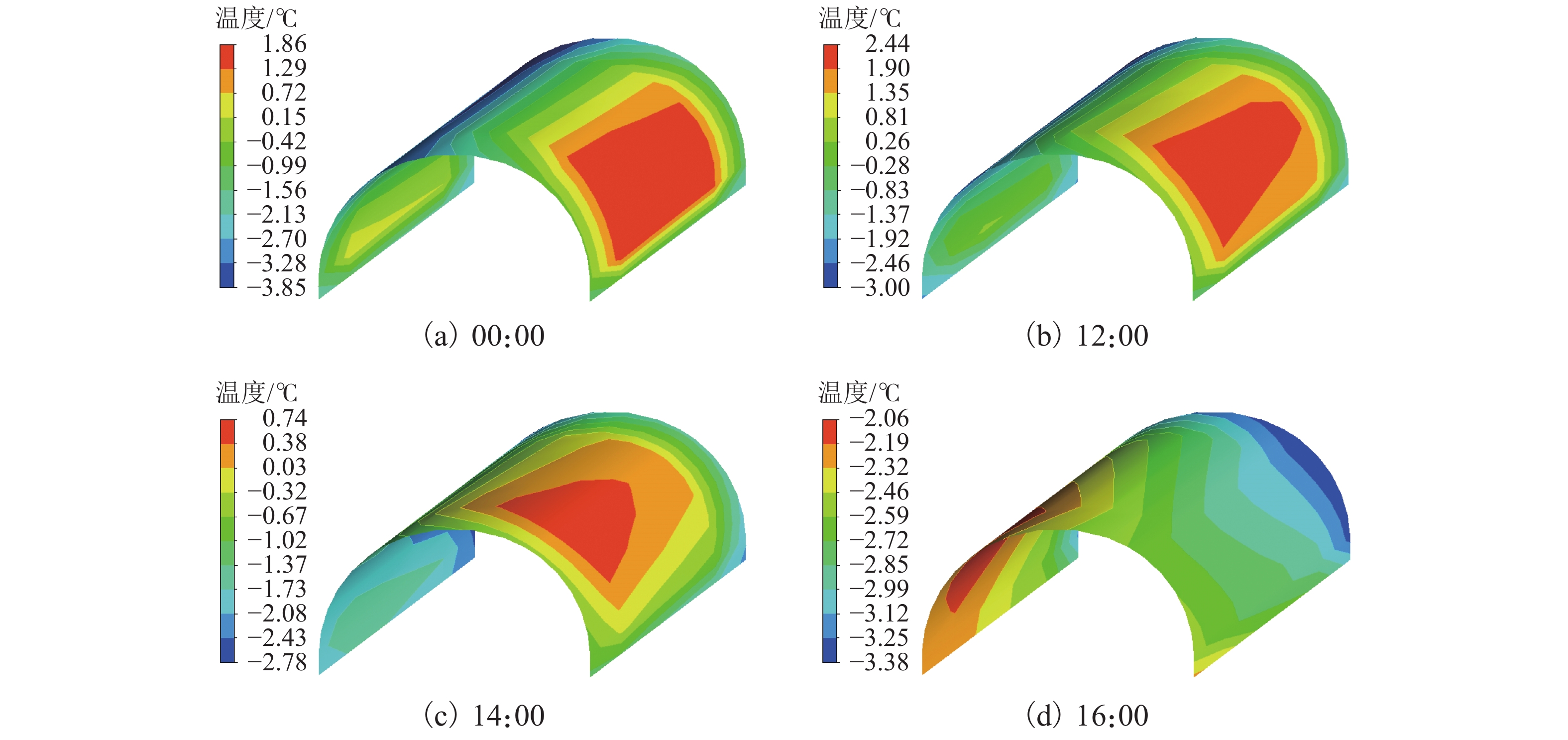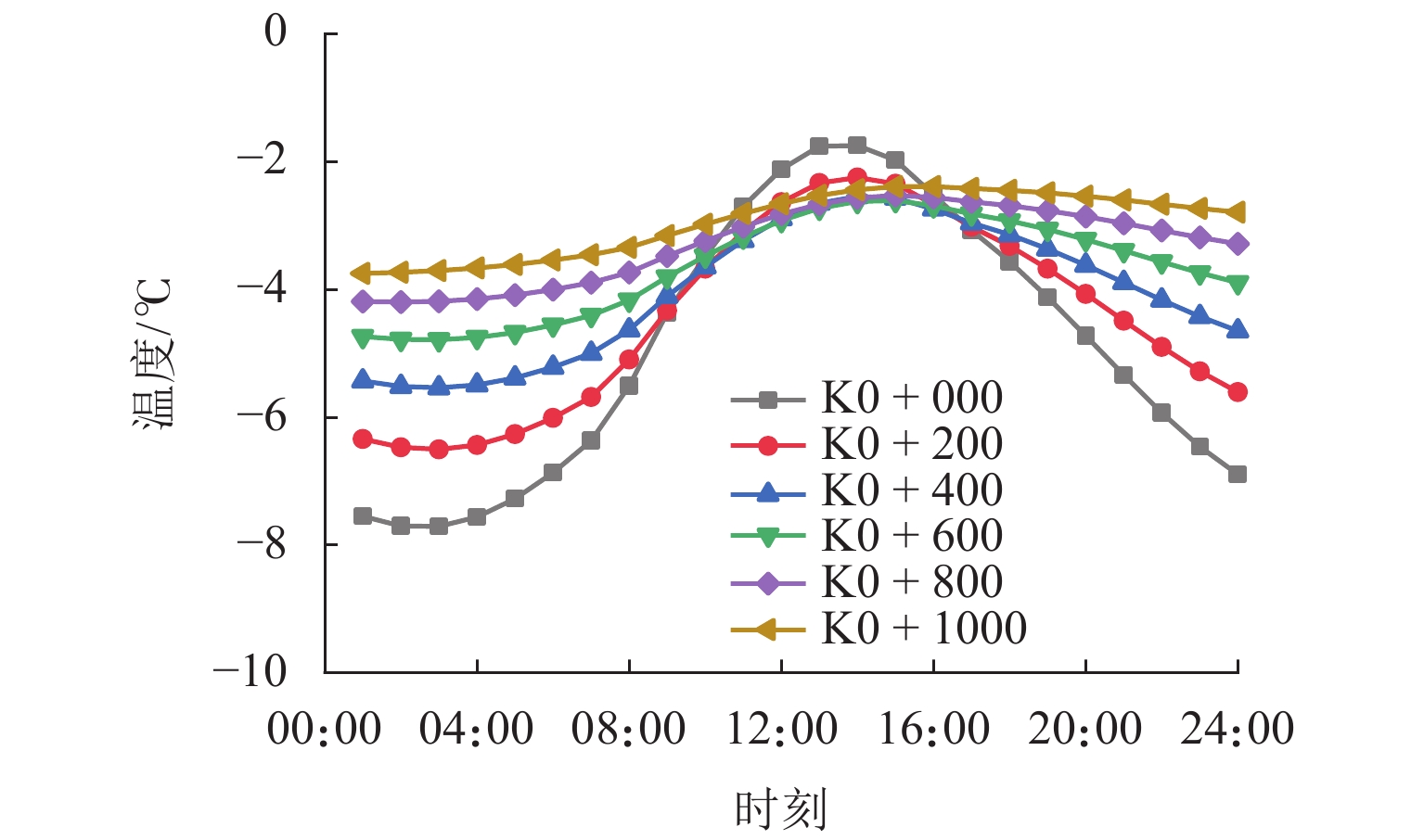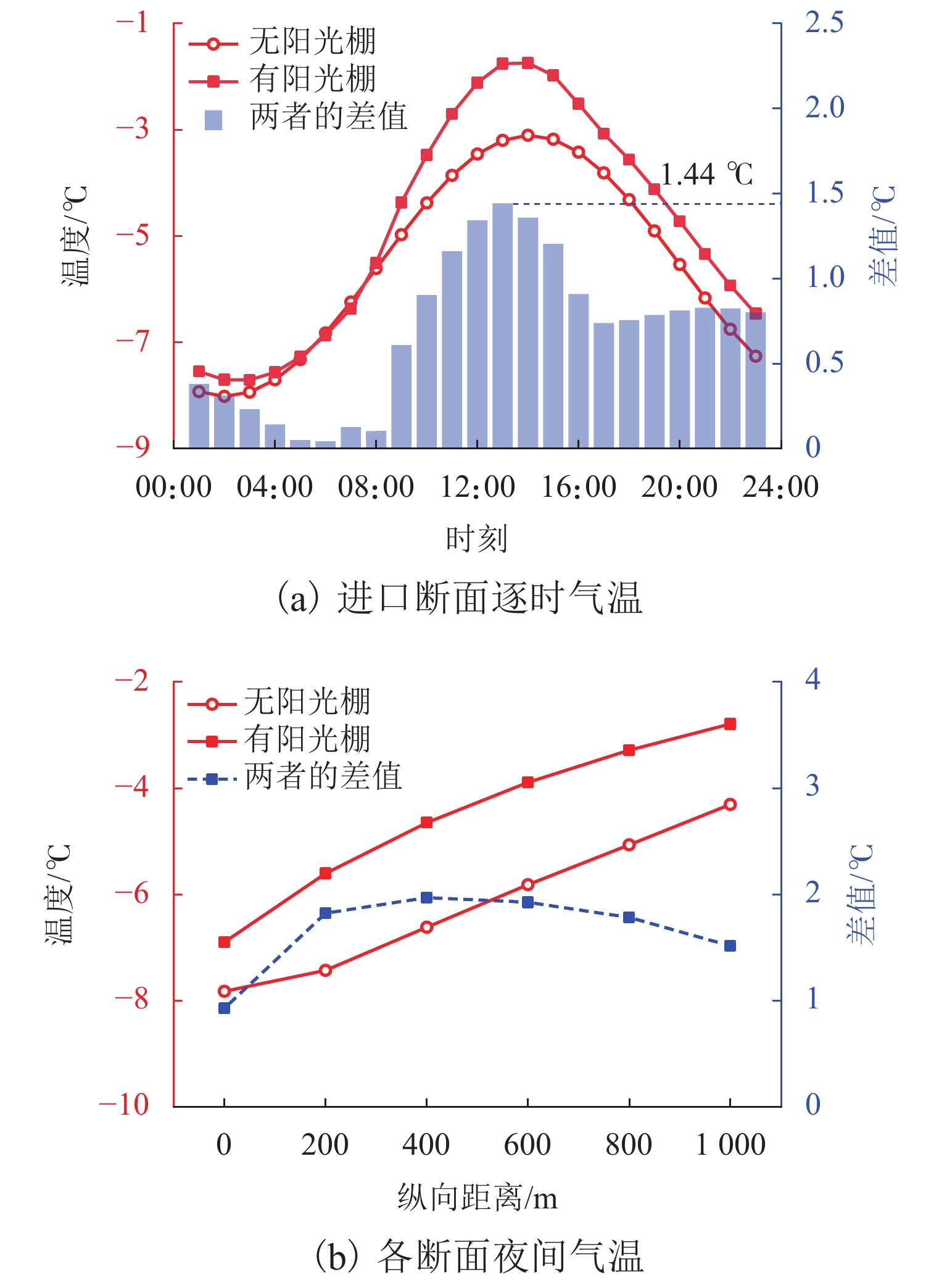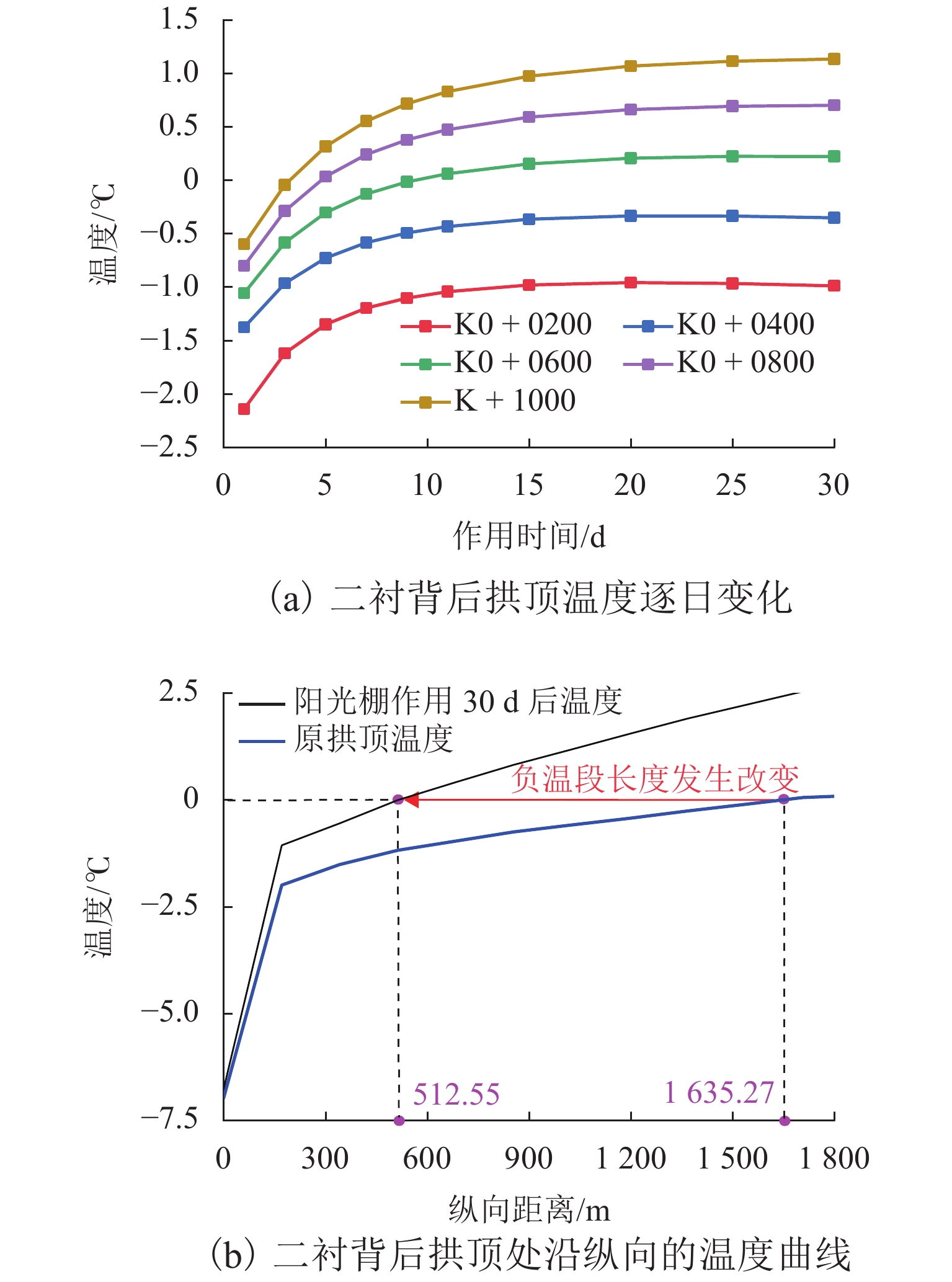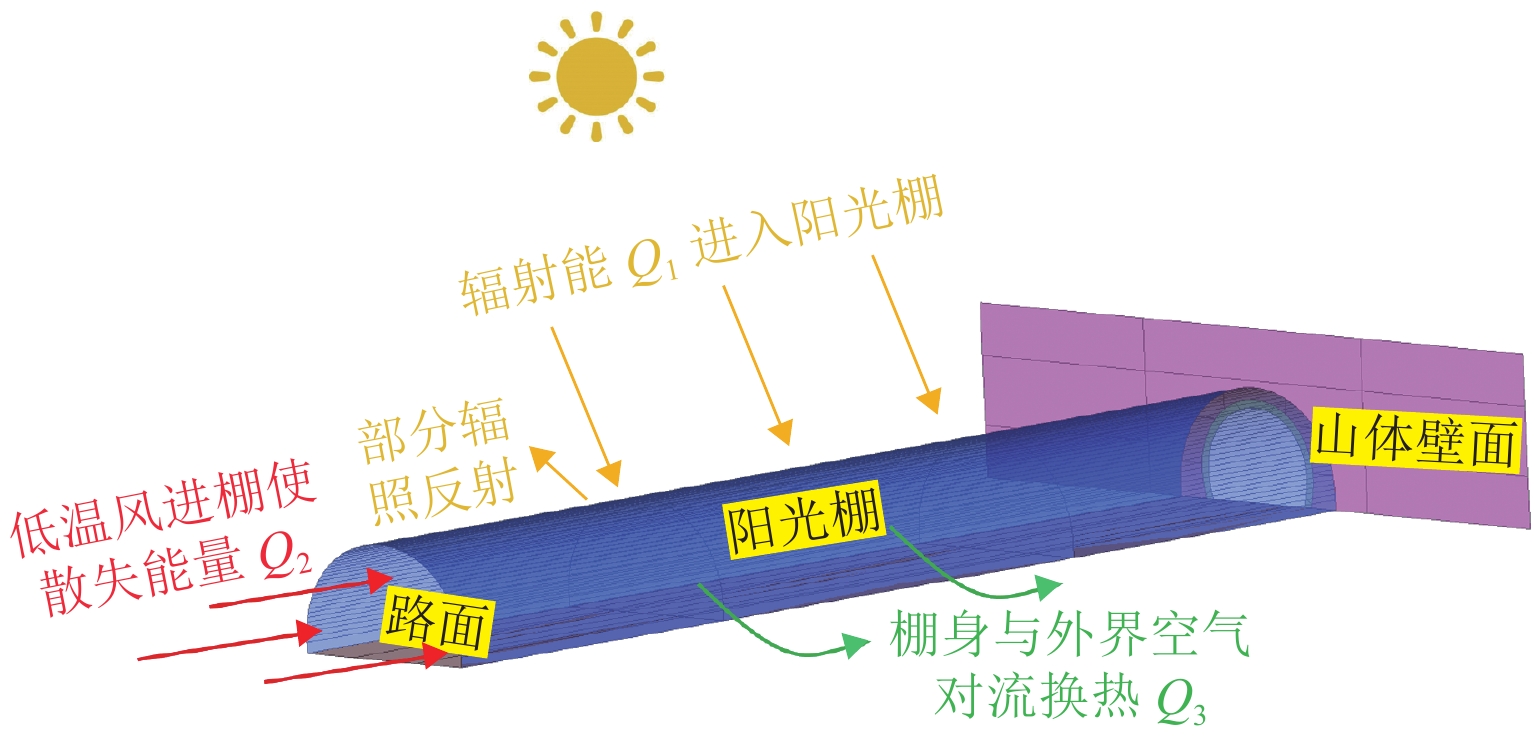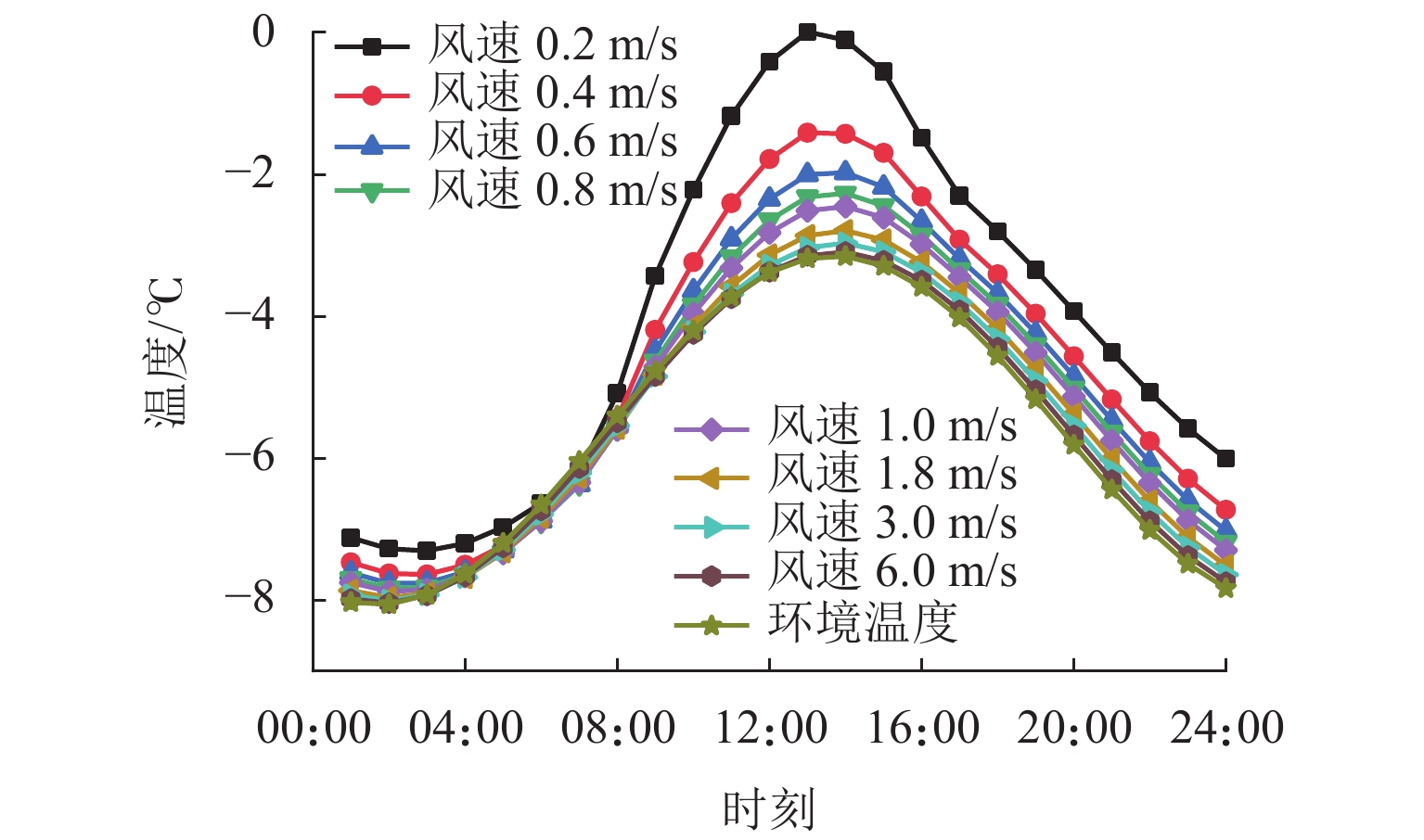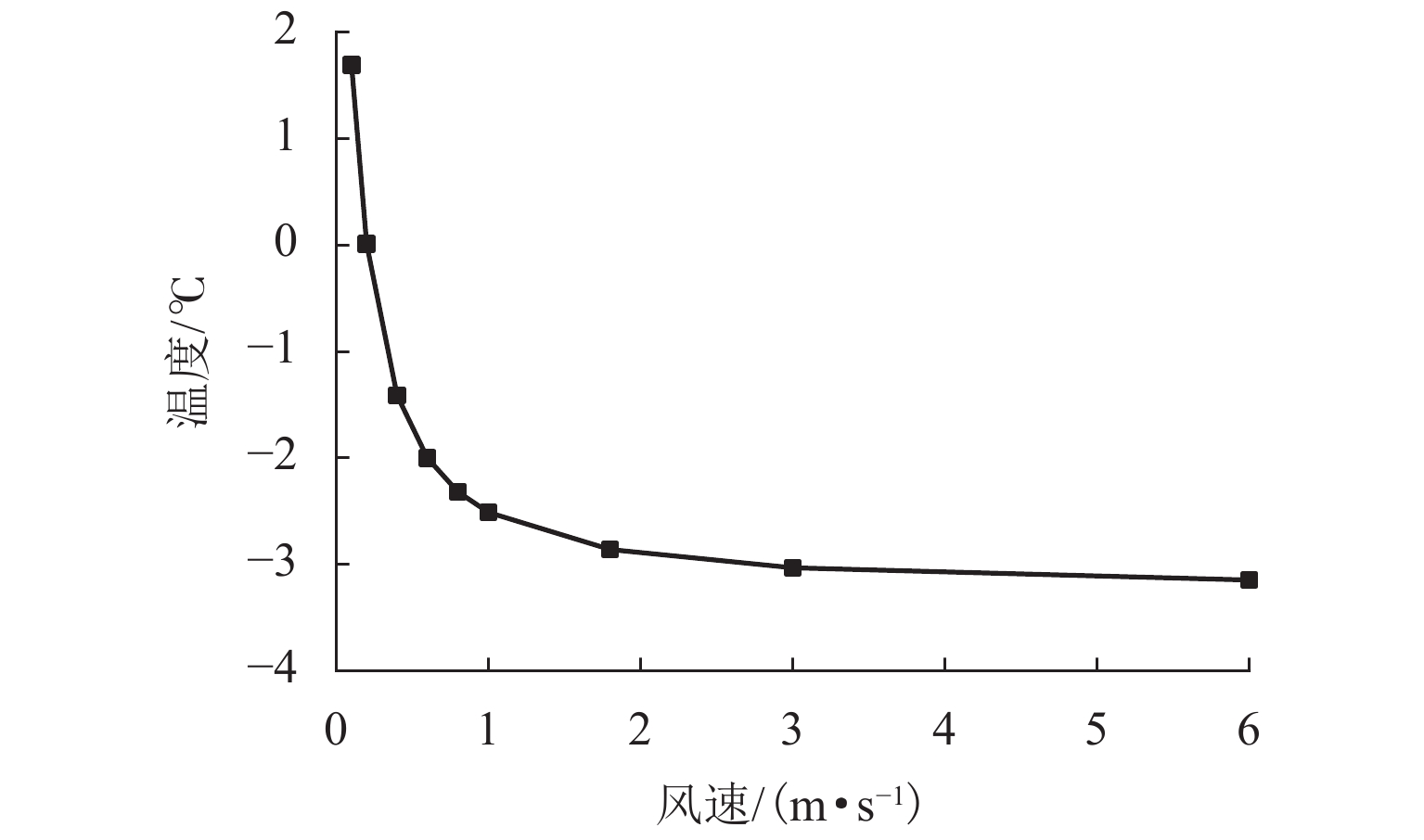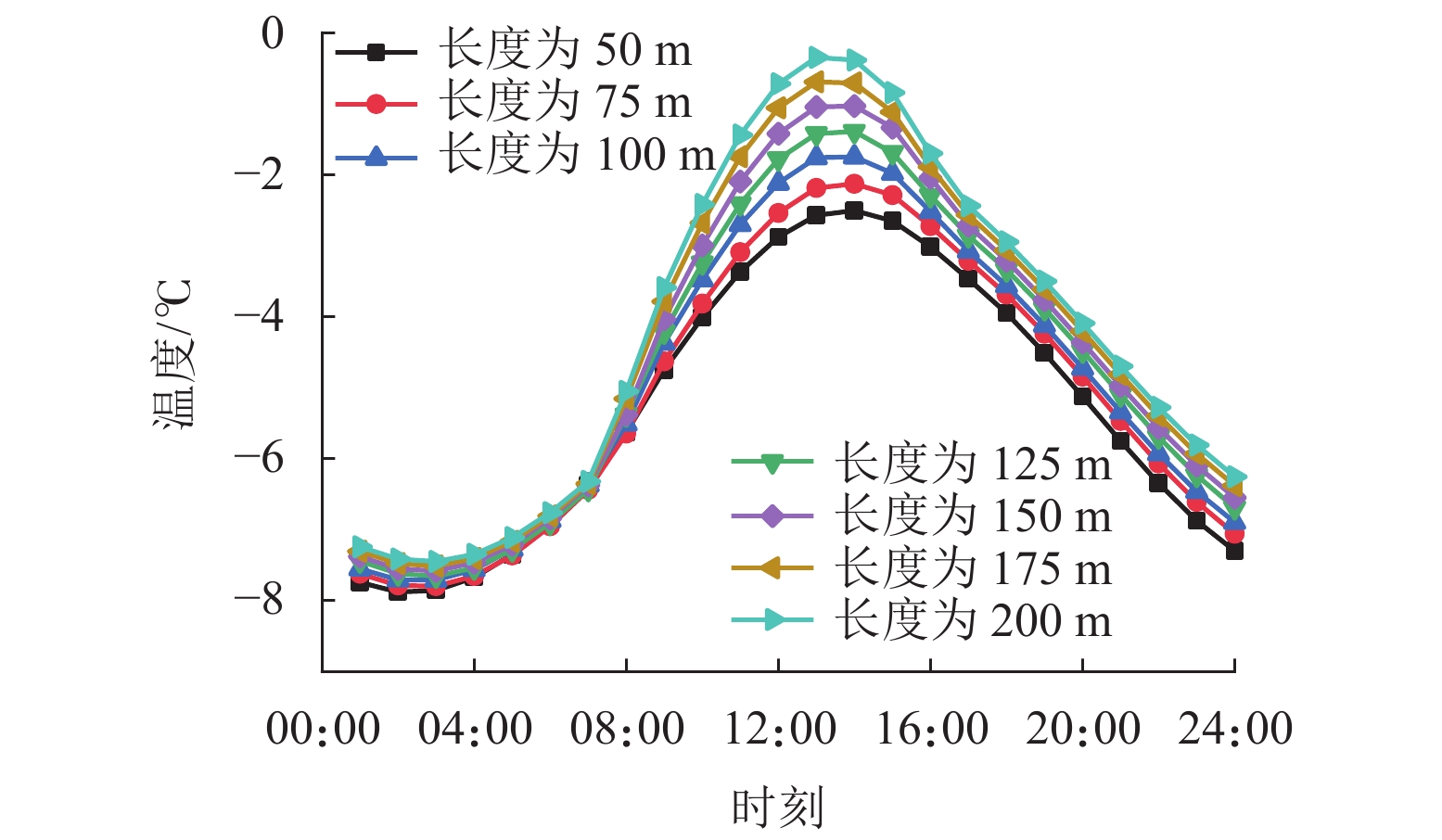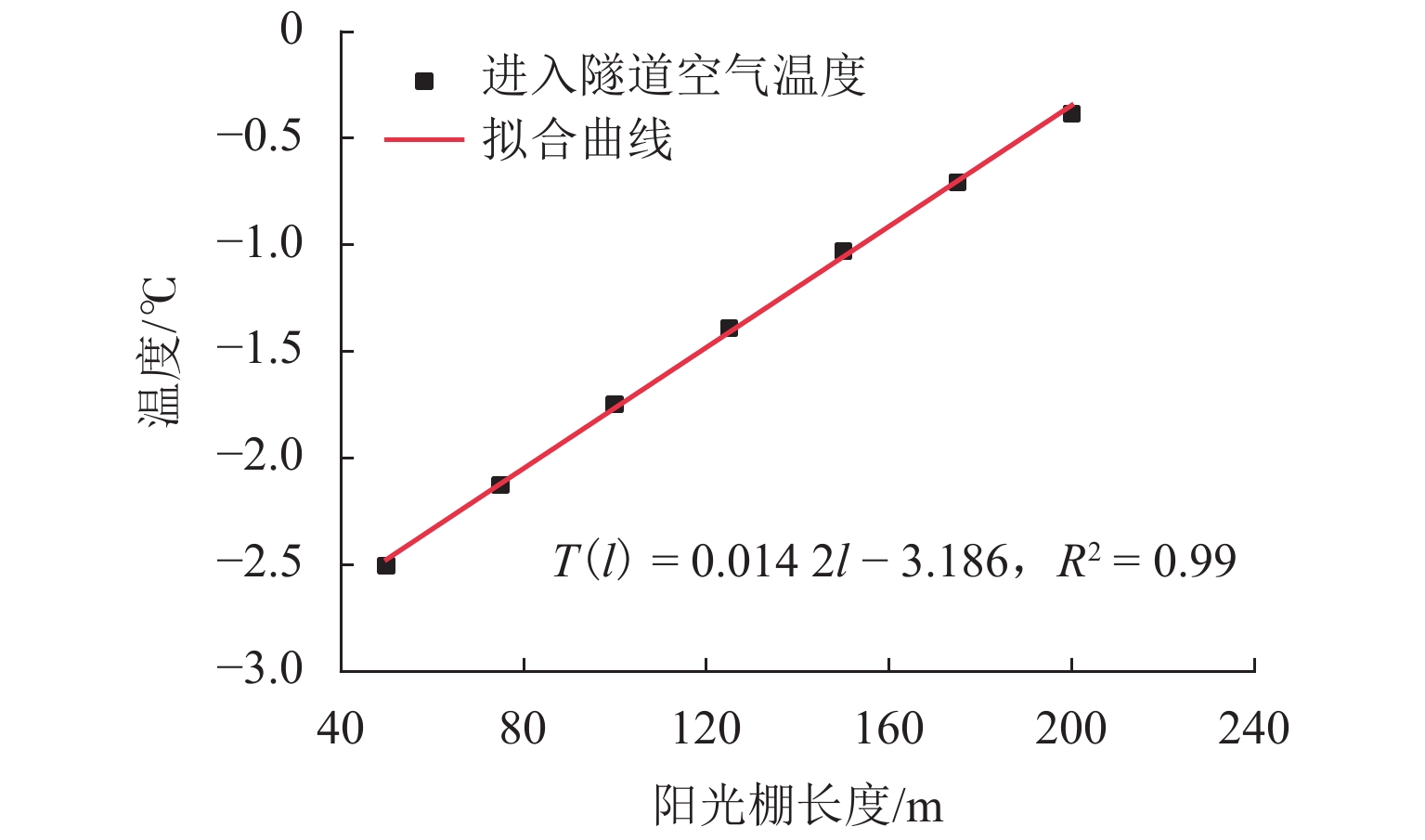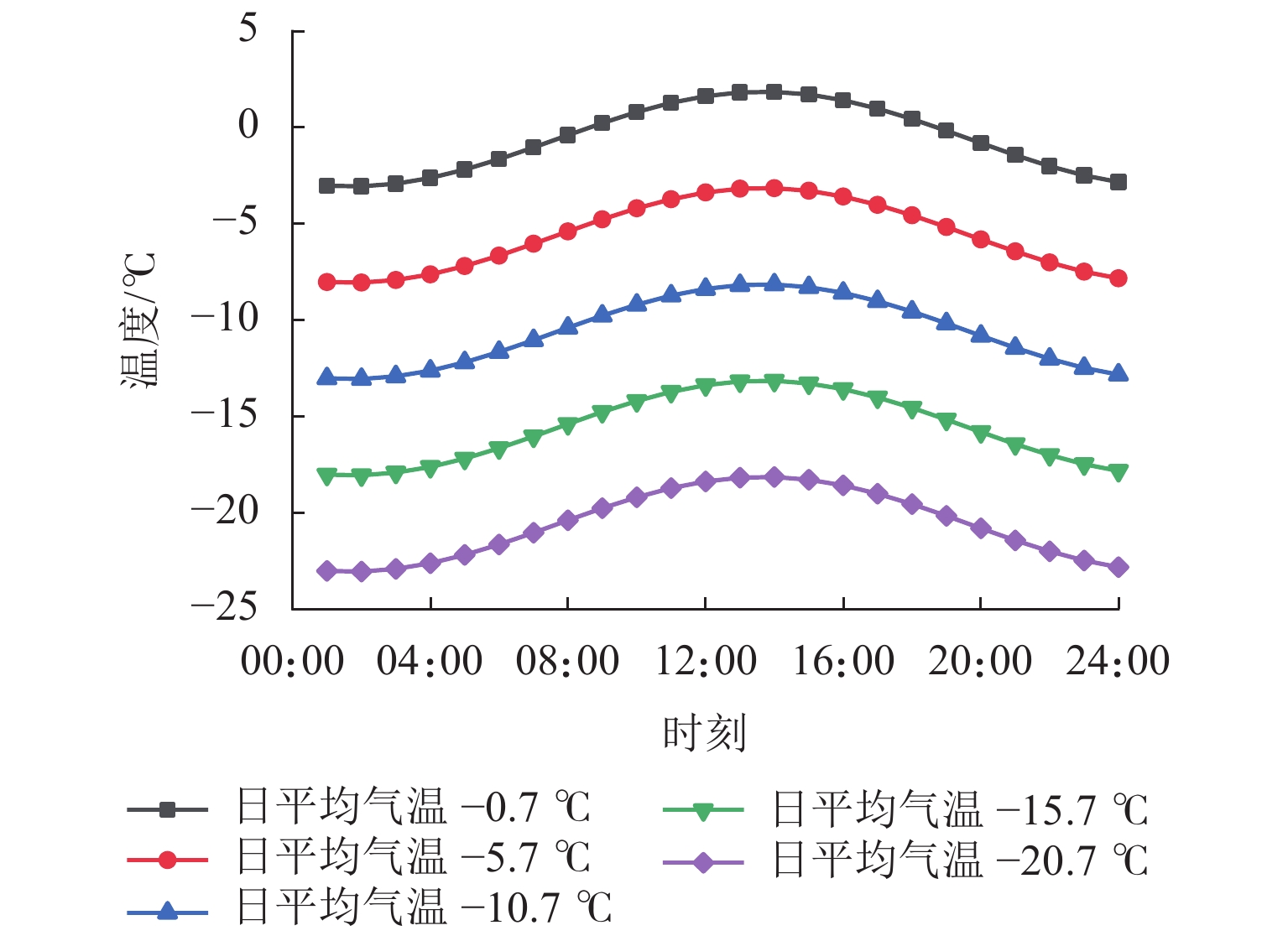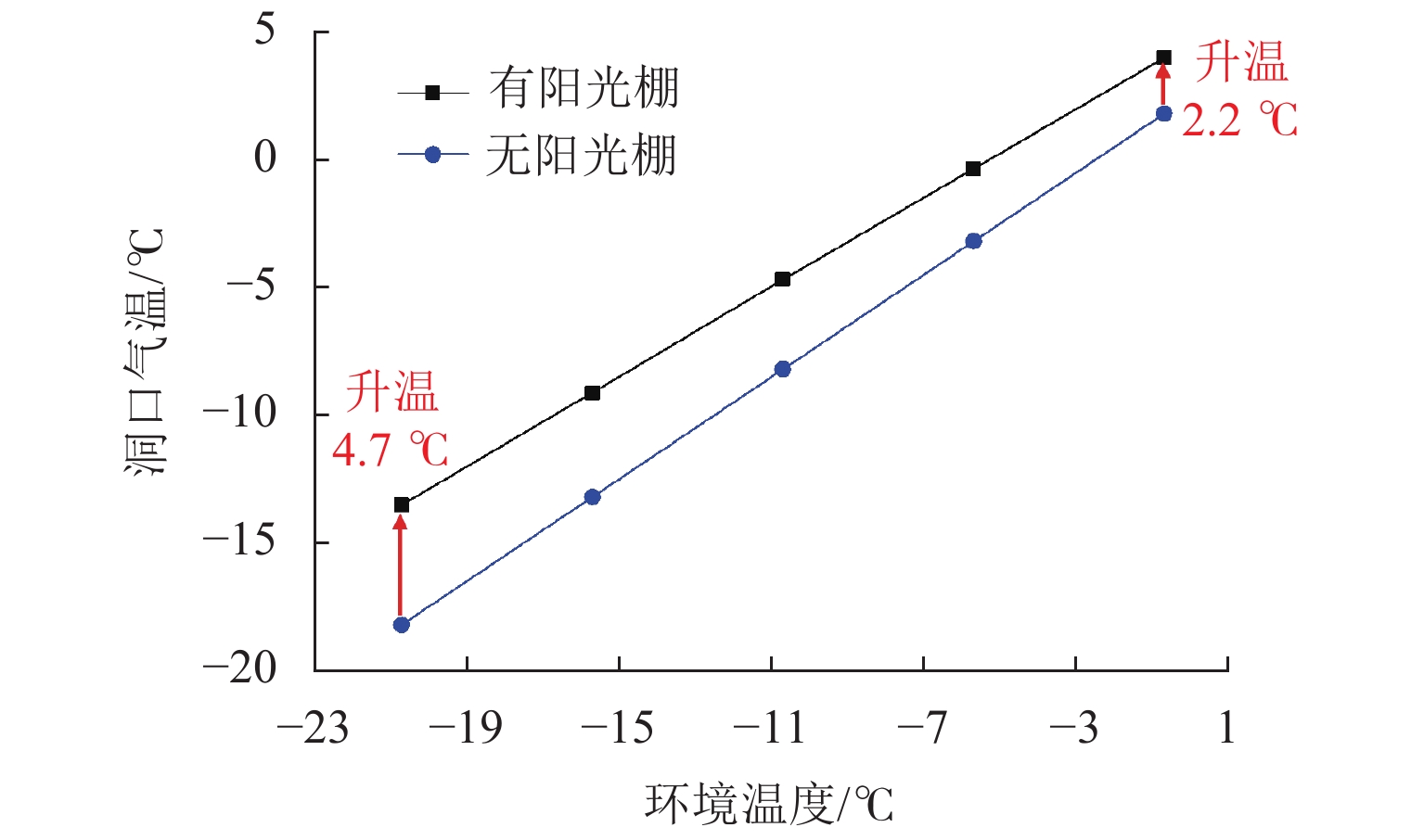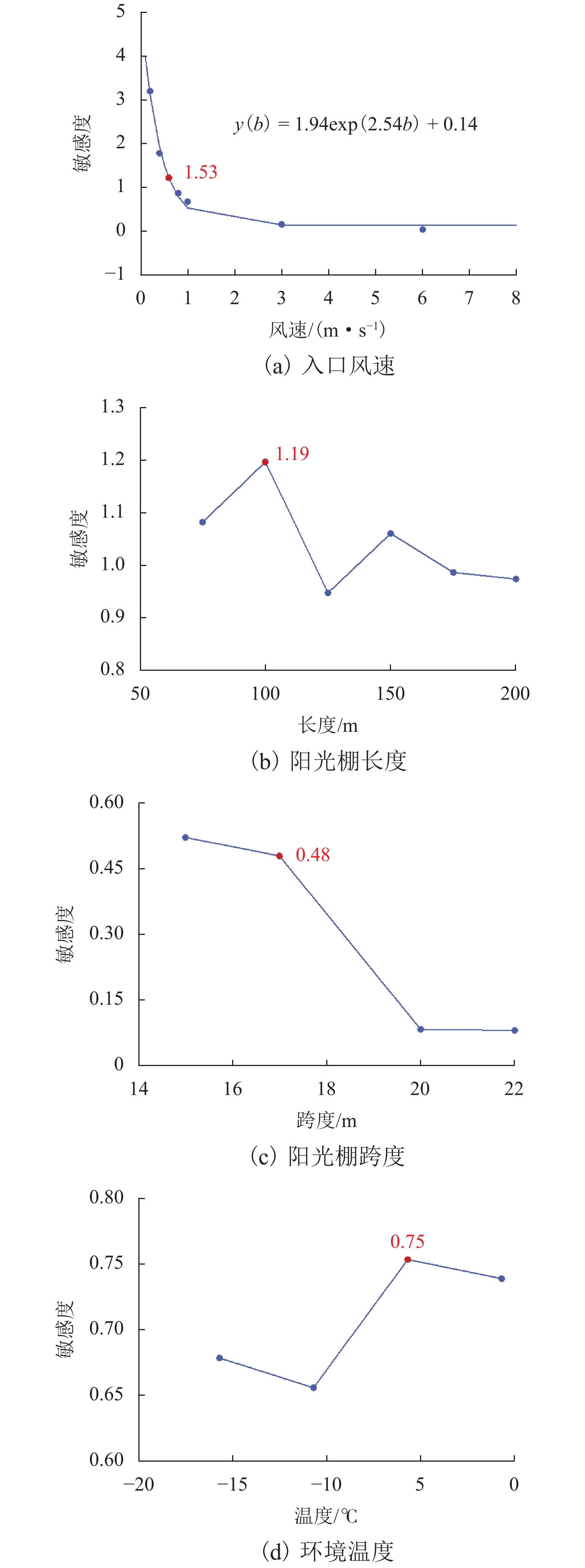Temperature Rise Effects and Impact of Solar Shed in Cold Region Tunnels
-
摘要:
为避免寒区隧道冻害问题产生,引入新型阳光棚防寒措施. 首先,建立三维瞬态传热数值模型,获得自然通风条件下的隧道温度场,并通过现场温度监测验证数值计算模型的可靠性;然后,通过数值方法验证阳光棚的温升效果,并进一步探究阳光棚入口风速、长度、跨度及环境温度对温升效果的影响;最后,对各因素进行敏感性分析,研究其对温升效果的影响程度. 研究结果表明:入口风速低于1.0 m/s时,阳光棚发挥良好的温升效果. 风速与温升效果呈负相关;长度每延长50 m,隧道进口气温升高0.71 ℃;跨度对温升效果的影响不明显;温升效果随环境温度变低而愈显著. 上述因素对温升效果的敏感性排序为:入口风速(0.39) > 长度(0.30) > 环境温度(0.19) > 跨度(0.12),其中,入口风速为最敏感因素,应用时应着重考虑. 因此,对阳光棚的使用建议为:低风速、大长度、小跨度.
Abstract:To avoid frost damage problems in cold regions tunnels, a solar shed was introduced as one of the insulation measures. First, a three-dimensional transient heat transfer numerical model was established to obtain the tunnel temperature field under natural ventilation, and the reliability of the numerical calculation model was verified through on-site temperature monitoring. Then, the temperature rise effects of the solar shed were demonstrated through numerical methods, and the effects of the solar shed’s speed, length, span, and ambient temperature on the temperature rise effects were further investigated. Finally, a sensitivity analysis was conducted on these factors to study their impact on temperature rise. The study results show that the solar shed has a good temperature rise effect when the wind speed is lower than 1.0 m/s. The wind speed was negatively related to the temperature rise effects. The air temperature at the tunnel entrance increases by 0.71 ℃ for every 50 m increase in length. The influence of the span on temperature rise effects is not obvious. The temperature rise effects become more and more significant as the ambient temperature becomes lower. The sensitivity of the above factors to temperature rise effects is ranked as follows: wind speed (0.39) > length (0.30) > ambient temperature (0.19) > span (0.12), of which the wind speed is the most sensitive factor and should be considered in the application. Therefore, the recommendation for the use of a solar shed is in environments with low wind speed, long tunnel lengths and small tunnel spans.
-
表 1 模型参数
Table 1. Parameters of the calculation model
名称 密度/
(kg·m−3)比热容/
(J·kg−1·K−1)导热系数/
(W·m−1·K−1)衬砌 2400 960 1.6 围岩 2025 1256 2.0 表 2 归一化后敏感度
Table 2. Sensitivity after normalization
因素 入口风速 阳光棚长度 跨度 环境温度 敏感度 0.39 0.30 0.12 0.19 -
[1] 陈仁升,康尔泗,吴立宗,等. 中国寒区分布探讨[J]. 冰川冻土,2005,27(4): 469-475.CHEN Rensheng, KANG Ersi, WU Lizong, et al. Cold regions in China[J]. Journal of Glaciology and Geocryology, 2005, 27(4): 469-475. [2] 张学富,王成,喻文兵,等. 风火山隧道空气与围岩对流换热和围岩热传导耦合问题的三维非线性分析[J]. 岩土工程学报,2005,27(12): 1414-1420.ZHANG Xuefu, WANG Cheng, YU Wenbing, et al. Three-dimensional nonlinear analysis for coupled problem of heat transfer of surrounding rock and heat convection between air in Fenghuo Mountain tunnel and surrounding rock[J]. Chinese Journal of Geotechnical Engineering, 2005, 27(12): 1414-1420. [3] 张国柱,夏才初,殷卓. 寒区隧道轴向及径向温度分布理论解[J]. 同济大学学报(自然科学版),2010,38(8): 1117-1122,1160. doi: 10.3969/j.issn.0253-374x.2010.08.003ZHANG Guozhu, XIA Caichu, YIN Zhuo. Analytical solution to axial and radial temperature of tunnel in cold region[J]. Journal of Tongji University (Natural Science), 2010, 38(8): 1117-1122,1160. doi: 10.3969/j.issn.0253-374x.2010.08.003 [4] WU H, ZHONG Y J, XU W, et al. Experimental investigation of ground and air temperature fields of a cold-region road tunnel in NW China[J]. Advances in Civil Engineering, 2020, 6: 1-13. [5] WU Y M, XU P, LI W B, et al. Distribution rules and key features for the lining surface temperature of road tunnels in cold regions[J]. Cold Regions Science and Technology, 2020, 172: 102979.1-102979.18. [6] ZHAO P Y, CHEN J X, LUO Y B, et al. Field measurement of air temperature in a cold region tunnel in northeast China[J]. Cold Regions Science and Technology, 2020, 171: 102957.1-102957.10. [7] ZHANG HM, CAO HB, ZHANG MJ. Analysis of temperature field of the tunnel surrounding rock in cold regions[J]. Advanced Materials Research, 2013, 753/754/755: 745-749. [8] WANG T, ZHOU G Q, WANG J Z, et al. Stochastic analysis for the uncertain temperature field of tunnel in cold regions[J]. Tunnelling and Underground Space Technology, 2016, 59: 7-15. doi: 10.1016/j.tust.2016.06.009 [9] YU Q Y, ZHANG C, DAI Z X, et al. Impact of tunnel temperature variations on surrounding rocks in cold regions[J]. Periodica Polytechnica Civil Engineering, 2019, 63(1): 160-167. [10] 孙克国,李思,许炜萍,等. 导热系数对寒区隧道温度场时空分布的影响[J]. 西南交通大学学报,2020,55(2): 256-264,289. doi: 10.3969/j.issn.0258-2724.20180530SUN Keguo, LI Si, XU Weiping, et al. Influence of thermal conductivity on temporal and spatial distributions of temperature filed in cold region tunnel[J]. Journal of Southwest Jiaotong University, 2020, 55(2): 256-264,289. doi: 10.3969/j.issn.0258-2724.20180530 [11] 郑余朝,孙克国,司君岭,等. 气流作用下的季冻区隧道温度场及影响因素[J]. 中国铁道科学,2020,41(6): 81-90.ZHENG Yuchao, SUN Keguo, SI Junling, et al. Tunnel temperature field and its influencing factors in seasonal frozen region subjected to action of airflow[J]. China Railway Science, 2020, 41(6): 81-90. [12] 王仁远,朱永全,高焱,等. 寒区隧道温度场模型试验及空气幕保温措施[J]. 中国铁道科学,2021,42(3): 70-82. doi: 10.3969/j.issn.1001-4632.2021.03.09WANG Renyuan, ZHU Yongquan, GAO Yan, et al. Model test of temperature field of tunnel in cold region and air curtain insulation measures[J]. China Railway Science, 2021, 42(3): 70-82. doi: 10.3969/j.issn.1001-4632.2021.03.09 [13] 冯强,蒋斌松. 多层介质寒区公路隧道保温层厚度计算的一种解析方法[J]. 岩土工程学报,2014,36(10): 1879-1887. doi: 10.11779/CJGE201410016FENG Qiang, JIANG Binsong. Analytical method for insulation layer thickness of highway tunnels with multilayer dielectric in cold regions[J]. Chinese Journal of Geotechnical Engineering, 2014, 36(10): 1879-1887. doi: 10.11779/CJGE201410016 [14] ZHAO P Y, CHEN J X, LUO Y B, et al. Investigation of the insulation effect of thermal insulation layer in the seasonally frozen region tunnel: a case study in the zuomutai tunnel, China[J]. Advances in Civil Engineering, 2019, 2019(4): 1-14. [15] LAI JX, GONG CB, WANG YS. Model test study on insulator of cold-region tunnel in northeast China: a case study of Gaoling tunnel[J]. Applied Mechanics and Materials, 2011, 71/72/73/74/75/76/77/78: 1870-1874. [16] YAN Q X, LI B J, ZHANG Y Y, et al. Numerical investigation of heat-insulating layers in a cold region tunnel, taking into account airflow and heat transfer[J]. Applied Sciences, 2017, 7: 7070679.1-7070679.22. [17] 成珂,马晓瑶,孙琦琦. 光伏温室大棚组件布置CFD模拟研究[J]. 太阳能学报,2021,42(8): 159-165.CHENG Ke, MA Xiaoyao, SUN Qiqi. CFD simulation study on module layout of photovoltaic greenhouse[J]. Acta Energiae Solaris Sinica, 2021, 42(8): 159-165. [18] 孙克国,杨朋,仇文革,等. 寒区隧道温度场和排水沟埋置深度研究[J]. 铁道工程学报,2017,34(4): 51-57.SUN Keguo, YANG Peng, QIU Wenge, et al. Research on the temperature field and the buried depth of drains for tunnels in cold region[J]. Journal of Railway Engineering Society, 2017, 34(4): 51-57. [19] 康德拉捷夫 К Я, 著. 太阳辐射能[M]. 李怀瑾, 译. 北京: 科学出版社, 1962. [20] 蔡毅,邢岩,胡丹. 敏感性分析综述[J]. 北京师范大学学报(自然科学版),2008,44(1): 9-16.CAI Yi, XING Yan, HU Dan. On sensitivity analysis[J]. Journal of Beijing Normal University (Natural Science), 2008, 44(1): 9-16. -





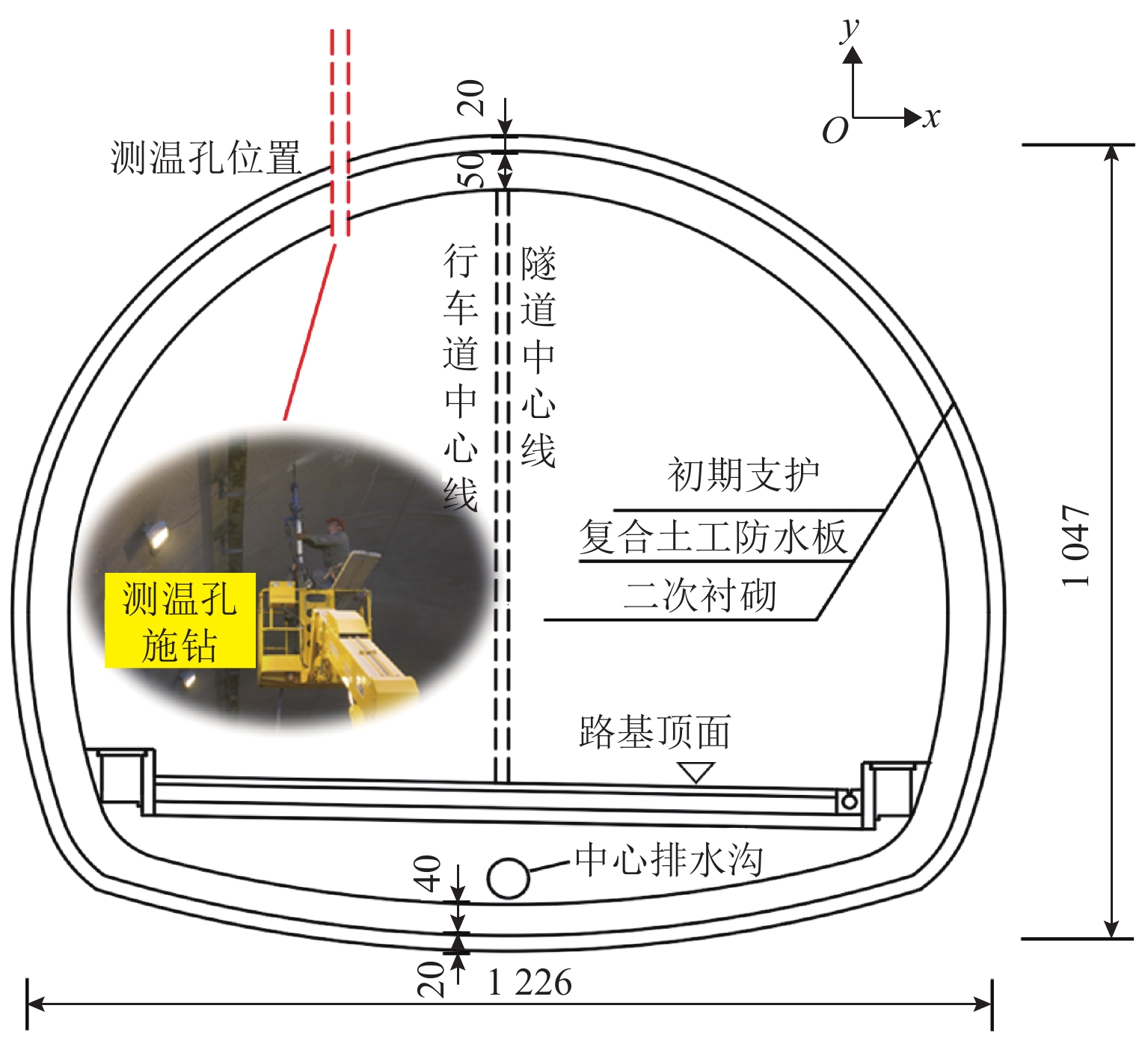
 下载:
下载:
